JHP Newsletter - 2011, No. 4, 22 July
Greetings from northern Idaho
Equipment: Really Right Stuff BH-55 Pro Ballhead
I've been using my new Really Right Stuff BH-55 Pro ballhead, or ball head if you prefer, for a few days and thought I'd share some initial thoughts about it. I had been using an Arca-Swiss B-1 ball head for about ten years, and the panning motion was no longer smooth enough to accurately track a moving subject, so I sent it in for an overhaul. When it came back, the panning motion was really stiff and it was even harder to track a moving subject! I had been thinking about the Really Right Stuff BH-55 Pro and had heard lots of good reviews and thought I'd try one out instead of ordering a new Arca-Swiss Z-1 ball head (the B-1 replacement) because I don't like the teardrop knob for the panning lock on the Z-1 — there's not enough clearance between it and the base plate.
The Really Right Stuff BH-55 Pro model comes with a knob to secure the camera clamp and has a wonderful build quality. The knurled knobs feel great in the hand and the black finish is nice — until you rub your fingernails on it when operating the knobs and then there are tracks all over it. I'm still getting used to having the panning lock on the opposite side of the ball lock — the Arca-Swiss B-1 and Z-1 have them both on the same side so it's possible to access all of the controls with your left hand while your right hand is holding onto the camera. The ball tension knob and the ball lock knob are also really high on the body so that the camera clamp can knock into them — the same controls on the Arca-Swiss B-1 and Z-1 are much lower and do not interfere with the camera clamp under most circumstances. The threads for the camera clamp and the ball lock are finer than on the Arca-Swiss B-1, so it takes several more turns to get the job done. The whole unit is about half an inch (1.3cm) shorter than the Arca-Swiss B-1, so it's possible to shoot from ever so slightly closer to ground level which is nice.
After using the Really Right Stuff BH-55 Pro for a few days, I'm not sure whether to recommend it. The Kirk BH-1 ballhead, which is similar to the Arca-Swis B-1, might be a better solution.
Travel: Yellowstone National Park
Beginning at the end of May, we spent two and a half weeks in Yellowstone National Park. That's a great time to be there for bear cubs, and other babies, and there aren't many visitors either. We didn't see any cubs-of-the-year, but we saw a grizzly bear sow with two yearling cubs on two different occasions, both of which weren't very good for photography. We had several good opportunities to photograph adult grizzly bears, and my favorite image is of one coming straight towards us (below left). We were photographing it from the car and it was about 20 yds (about 20m) away when I took the picture. One of the most interesting encounters we had was a male dusky grouse (formerly a blue grouse) displaying (below right). He was at it for at least 30 minutes while we were there, and other photographers said he had been doing it for about three hours!
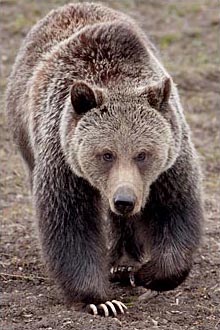
1/350 sec, f8, ISO 400
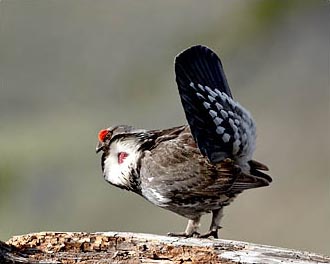
1/500 sec, f8, ISO 250
We photographed wildflowers one morning, and I just love this image of two Alpine shooting star blossoms (below left). Another afternoon, we were walking through a meadow looking for a badger when we discovered a mountain bluebird nest in a tree. The two adults were busy collecting food for their chicks and would land on a nearby perch (below right) before continuing on into the nest.
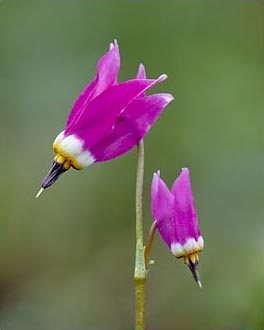
1/45 sec, f5.6, ISO 100
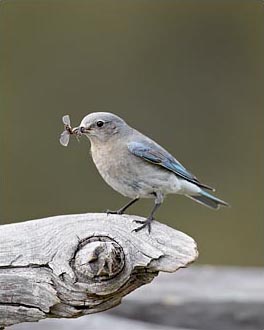
1/500 sec, f6.7, ISO 400
Another morning we photographed some Barrow's goldneyes, and only a female swam close enough for some great shots (below left). It was while photographing the goldeneyes that I noticed the panning motion of my Arca-Swiss B-1 was jerky. Near the same meadow where we found the bluebird nest, I photographed a cooperative chipmunk (below right).
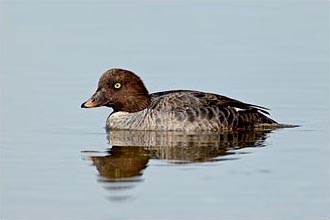
1/1000 sec, f8, ISO 320
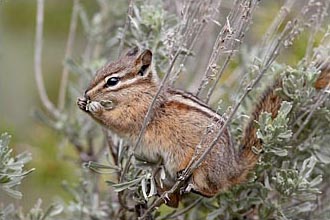
1/350 sec, f8, ISO 400
Travel: Glacier and Waterton Lakes National Parks
After we left Yellowstone National Park in mid June, we boondocked in the Gallatin National Forest and the Helena National Forest for about two weeks to relax a bit and get some office work done after the gruling time in Yellowstone where we were frequently out photographing from dawn to dusk. I also sent my Arca-Swiss B-1 in for an overhaul. We had a really nice site in the Gallatin National Forest right next to Ted Turner's Flying D ranch. In fact, we had to drive through his ranch, and his large herd of bison, to get to our boondocking spot.
There was a nice meadow of wildflowers blooming right where we camped, and one evening we went out to photograph them. One of my favorite images of this Travel Update is of a glacier lily (below left). Usually the six petals curl back symmetrically, but two of the petals on this bloom curled off-axis and created a nice s-curve.
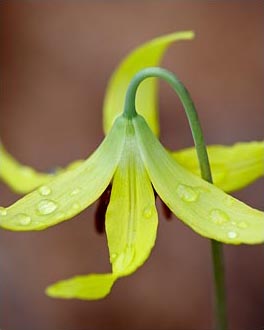
1/15 sec, f5.6, ISO 100
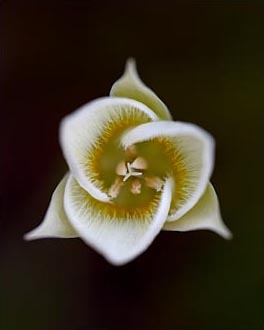
1/45 sec, f4, ISO 100
At the end of June, we went to the east side of Glacier National Park and stayed in the Two Medicine area for three nights, then the St. Mary area for five nights, and finally the Many Glacier area for two nights. It was extremely windy most of the time we were in the park and we didn't see much wildlife, although the latter might have been because we were mostly hiding out in the RV seeking shelter from the wind. It was calm enough on two mornings to photograph some wildflowers when we were at St. Mary, and I was able to take a fantastic image of a pointed mariposa lily starting to open up (above right).
Another morning at St. Mary I went to photograph sunrise at Sun Point. It's my favorite place to photograph at sunrise in the park because it's possible to photograph the sun rising in the east and also first light on the peaks to the west. The clouds to the east weren't that interesting, but I loved first light on Dusty Star Mountain (below left). One evening, we went to Baring Creek to photograph the falls and cascades when they were in shade after the sun had set behind the mountains. I found a new composition of the cascades that really worked well, especially when converted to black-and-white (below center). I used NIK Silver Efex Pro for the first time on this image, and I was able to produce a more pleasing image with it than I could with just Photoshop.
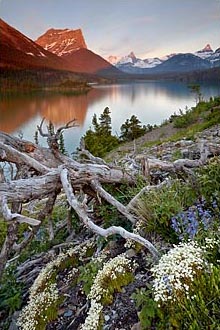
At First Light
2-stop hard grad ND,
2-stop soft grad ND,
1.5 sec, f11, ISO 100
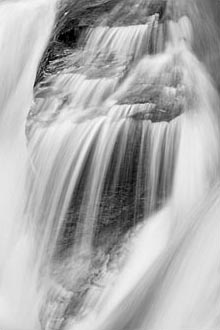
70-200 2.8 IS II (at 145mm),
polarizer, 1/2 sec, f11, ISO 100
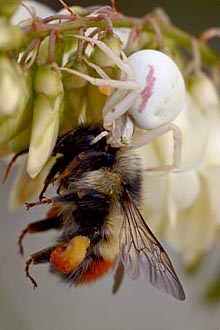
Red-Tailed Bumble Bee
Alberta, Canada
1/8 sec, f11, ISO 100
Because conditions weren't very good in the Many Glacier area, we went up to Waterton Lakes National Park just across the border in Canada and spent seven nights there. While photographing wildflowers one morning, I spotted a bee in some yellow sweetvetch. As I approached, I couldn't figure out how the bee was hanging onto the flowers because it was at an odd angle. As I looked closer, I saw that a goldenrod spider was holding and eating the bee (above right) — no wonder the bee looked odd!
We had several good opportunities to photograph black bears. One cinnamon black bear paused right by the side of the road and I was able to get a nice image of it eating some grass (below left). Another evening, a sow with two cubs-of-the-year stayed out in a meadow for a while and I was able to get a nice image of one of the cubs (below right).
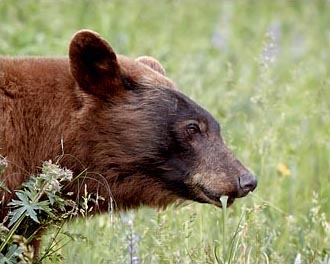
Alberta, Canada
1/125 sec, f8, ISO 400
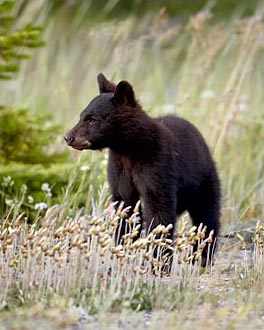
Alberta, Canada
1/60 sec, f5.6, ISO 400
Another morning we photographed wildflowers at a different location and I was able to get my first images of a wood lily (below left) and a mountain lady's slipper, a kind of orchid. While in the park, I also photographed a prairie smoke (wildflower) at three stages in the same image (below right): budding, flowering, and seeding.
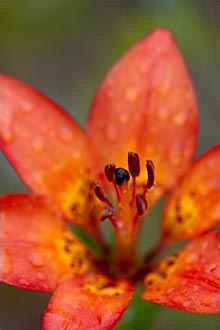
Alberta, Canada
1/60 sec, f5.6, ISO 100
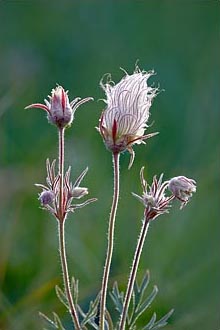
Alberta, Canada
1/20 sec, f8, ISO 100
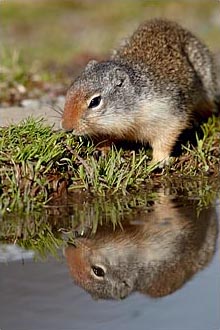
1/750 sec, f8, ISO 250
We returned to Glacier National Park and spent two nights at St. Mary. We were excited to head up to Logan Pass after the road had opened while we were in Waterton. It was one of the latest road openings ever due to the large amount of snow that had fallen over the winter. The hillside behind the visitor center at Logan Pass (6646 ft, 2025m) was still covered with at least three ft, about one meter, of snow! There was a small area clear of snow right near the visitor center, and several Columbian ground squirrels were busy feeding on the vegetation. I just love photographing the little guys, and one of them went over to feed at the edge of a small puddle which created a nice reflection (above right).
Take care and happy shooting.
— James
James Hager Photography :: www.jameshagerphoto.com




